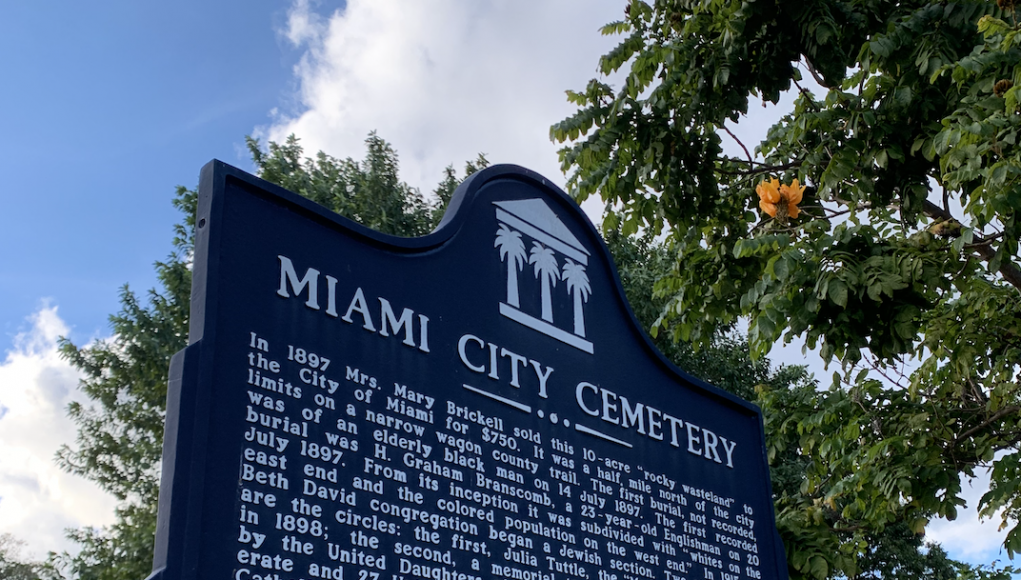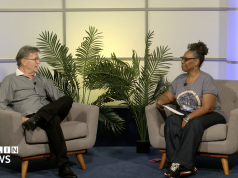The Miami City Cemetery, a 10-acre plot of land just south of the rapidly gentrifying Wynwood area and east of the still struggling Overtown neighborhood, holds the earthly remains of some of the city’s Black incorporators and other pioneers – the first Black attorney and judge among them – some of whom are well remembered while others have all but faded from memory.
Back in 1897, about a year after the city of Miami was incorporated, officials purchased the land from Mary Brickell for $750.
Marvin Dunn is a former Florida International University professor as well as an author and historian. In his book “Black Miami in the Twentieth Century,” he wrote about the city’s incorporation and the Black experience in the years and decades that followed.
The cemetery itself is a tangible reminder of that story. According to Dunn’s book, the Great Freeze of the 1890s nearly destroyed the agriculture of the southern United States. As a result, Julia Tuttle, often referred to as the mother of Miami, invited Henry Flagler to extend his Florida East Coast Railway to Biscayne Bay.
Flagler agreed, bringing the rail to the warmth of South Florida in 1896. This, in turn, led Tuttle and others to incorporate the growing village with the help of 162 votes from Black men, slightly under half of the total 368 “yes” ballots.
At the time, most of Miami’s Black population was made up of people from the Bahamas and the southern United States. They lived primarily in Coconut Grove and Overtown, then known as Colored Town.
Paul George is the resident historian at the History of Miami Museum. He is also a history professor at Miami-Dade College and has given tours all around Miami.
From the date of its purchase in 1897, the cemetery was segregated by race and religion. The Whites were buried on the east side and Blacks were on the west side. It remained that way until the 1960s.
“Cemeteries were included in the segregation,” said George of the so-called Jim Crow laws at the time. “In other words, you’re apart in life and you’re apart in death, based on race.”
Although the first burial at the cemetery was not officially recorded, local lore claims it was an elderly Black man who died of edema and whose resting place remains unknown. The first official burial was of H. Graham Bascomb, a White man who died of tuberculosis on July 20, 1897.
“The history of Black people in that cemetery is similar to the history of Black people in most cemeteries in southern towns,” said Dunn. “Black people were buried in the back of cemeteries in segregated areas of the cemetery. So, the city of Miami Cemetery is typical of cemeteries during that time.”
Up until the end of the twentieth century, the cemetery was frequently vandalized. But in the 1990s, the Dade Heritage Trust, TREEmendous Miami, and other organizations began to work to preserve the historical plots.
From the 1980s until about five years ago, the Dade Heritage Trust held annual “Dade Heritage Days” to celebrate Miami’s history and culture. Enid Pinkney, who became the trust’s first Black president in 1998, noted at the time that there wasn’t really anything being done to commemorate Miami’s Black history.
“As I looked at it, there was nothing there that celebrated the Black history, heritage and culture,” said Pinkney. “We formed the African American committee, so that we could have a contribution in this program.”
In 1994, the trust started to hold commemorative services as a part of Dade Heritage Days to honor those who are buried and forgotten. On a Sunday in April, they’d march from St. Agnes Episcopal Church, alongside a marching band, to the cemetery and hold a funeral procession. In the early 2000s they began to honor some of the city’s Black incorporators with new headstones often many decades after their passing.
Penny Lambeth, who was the vice-president of the trust at that time, started her own committee: the Miami Cemetery Task Force, which had the goal of transforming the cemetery into a beautiful garden that would allow people to explore its history and admire the scenery. Lambeth died in 2016.
Today, the grounds are protected by a high fence and maintained by both Miami city employees and volunteers.
Ronnie Hurwitz has spent over 30 years cleaning up and attending to the cemetery without any pay. He serves as a chairman of the Historic Miami City Cemetery Restoration Committee.
“I’d go to the Miami-Dade Library genealogy section, and I’d have the newspaper articles from when they died in my hand,” said Hurwitz, recalling how he’d capture the story of each individual.
There are over 9,000 people buried in the cemetery, near its 10,000-plot capacity. Though people continue to be buried to this day, the only way to get in is to prove you have the deed to a space.
Here are some notable people interred there:
City of Miami Incorporators
These were some of the Black men that participated in the vote towards the incorporation of the City of Miami in 1896. They were buried in the Miami City Cemetery and have been honored with new tombstones.
- Christopher C. Scott 1871-1905
- William D. Bascomb 1866-1902
- Samuel Jones 1890-1920
- London Blackstone 1856-1905
- Joseph Cooper 1848-1908
- John Ross 1873-1911
- George Carr 1890-1920
M.T. Mitchell, who died in 1902, was the first African American undertaker and embalmer in the City of Miami. He also took part in the vote for the city’s incorporation.
Alexander C. Lightburn was an African American founder of the City of Miami. Lightburn, who died in 1908, was listed as an incorporator of the city and was a founder and trustee of the Bethel A.M.E Church.
Dr. Irene G. Prat, who died in 1996, was the first Black baby born in Miami-Dade County in 1896. She was the daughter of Bahamian settlers Rev. Samuel and Margarett Sampson, who were the founders of the first Black Baptist church in the City of Miami.
John Stephens, who died in 1947, was a Black pioneer and one of the founding members of the Historic Mt.Zion Baptist Church, which served as a meeting ground for Civil Rights Activists like Dr.Martin Luther King Jr. and the Boy and Girl Scouts.
Richard E.S. Toomey was the first Black attorney in the City of Miami. Toomey, who died in 1948, was a vital part of Black Miami’s growing professional population. He served in the Spanish-American war.
Rev. Theodore Gibson was a civil rights activist and the president of Miami’s NAACP chapter. Gibson, who died in 1982, was a leader in the community, devoting his time to preaching at Christ Episcopal Church in Coconut Grove, as well as serving as a city commissioner.
Bernard Arthurneal Mackey was a singer and guitarist. Mackey, who died in 1980 was a member of the Ink Spots, a very famous singing group. They were amongst the first Black artists to perform on television.
Lawson E. Thomas was the first Black judge in Miami. Thomas, who died in 1989, was a civil rights activist and made the utmost effort to change Miami’s social and political landscape, using the law to his advantage.
(Read part of the series here.)
































